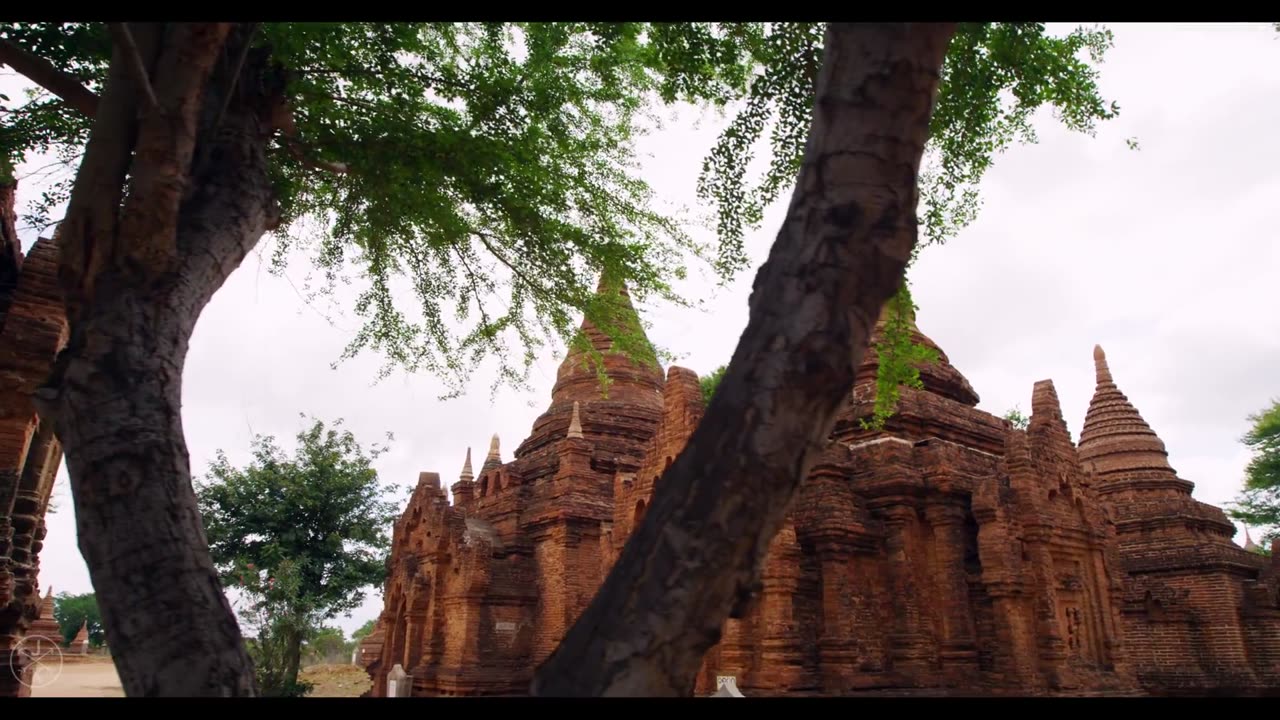Premium Only Content

Myanmar ( Burma )
"Burma" redirects here. For other uses, see Burma (disambiguation).
Republic of the Union of Myanmar
ပြည်ထောင်စု သမ္မတ မြန်မာနိုင်ငံတော် (Burmese)
Pyidaunzu Thanmăda Myăma Nainngandaw
Flag of Myanmar
Flag
State Seal of Myanmar
State Seal
Anthem: ကမ္ဘာမကျေ
Kaba Ma Kyei
"Till The World Ends"
Duration: 40 seconds.0:40
Show globe
Show map of ASEAN
Show all
Location of Myanmar (green)
in ASEAN (dark grey) – [Legend]
Capital Naypyidaw[a]
19°45′N 96°6′E
Largest city Yangon[b]
Official language Burmese
Recognised regional languages[1]
ChinKachinKarenKayahMonRakhineShan
Ethnic groups (2018[2][3])
68% Bamar
9% Shan
7% Karen
4% Rakhine
3% Chinese
2% Indians
2% Mon
5% other
Religion
87.9% Buddhism (official)[4]
6.2% Christianity
4.3% Islam
1.6% other[5]
Demonym(s) Burmese / Myanma[6]
Government Unitary assembly-independent republic under a military junta
• President
Myint Swe (acting)
• SAC Chairman and Prime Minister
Min Aung Hlaing
• SAC Vice Chairman and Deputy Prime Minister
Soe Win[c]
Legislature State Administration Council
Formation
• Pagan Kingdom
23 December 849
• Toungoo dynasty
16 October 1510
• Konbaung dynasty
29 February 1752
• Annexation by Britain
1 January 1886
• Independence
from the United Kingdom
4 January 1948
• 1962 coup d'état
2 March 1962
• Renamed from "Burma" to "Myanmar"
18 June 1989
• Dissolution of military government
30 March 2011
• 2021 coup d'état
1 February 2021
Area
• Total
261,227 sq mi (676,570 km2) (39th)
• Water (%)
3.06
Population
• 2022 estimate
57,526,449[9] (26th)
• Density
196.8/sq mi (76.0/km2) (125th)
GDP (PPP) 2023 estimate
• Total
Increase $277.767 billion[10] (64th)
• Per capita
Increase $5,124[10] (146th)
GDP (nominal) 2023 estimate
• Total
Increase $74.861 billion[10] (90th)
• Per capita
Increase $1,381[10] (167th)
Gini (2017) Positive decrease 30.7[11]
medium
HDI (2021) Decrease 0.585[12]
medium · 149th
Currency Kyat (K) (MMK)
Time zone UTC+06:30 (MMT)
Driving side right
Calling code +95
ISO 3166 code MM
Internet TLD .mm
This article contains Burmese script. Without proper rendering support, you may see question marks, boxes, or other symbols instead of Burmese script.
Myanmar (Burmese: မြန်မာ; MLCTS: mranma, pronounced [mjàɴmà]), officially the Republic of the Union of Myanmar,[d] also known as Burma (the official name until 1989), is a country in Southeast Asia. It is the largest country by area in Mainland Southeast Asia and has a population of about 55 million.[13] It is bordered by Bangladesh and India to its northwest, China to its northeast, Laos and Thailand to its east and southeast, and the Andaman Sea and the Bay of Bengal to its south and southwest. The country's capital city is Naypyidaw, and its largest city is Yangon (formerly Rangoon).[3]
Early civilisations in the area included the Tibeto-Burman-speaking Pyu city-states in Upper Myanmar and the Mon kingdoms in Lower Myanmar.[14] In the 9th century, the Bamar people entered the upper Irrawaddy valley, and following the establishment of the Pagan Kingdom in the 1050s, the Burmese language, culture, and Theravada Buddhism slowly became dominant in the country. The Pagan Kingdom fell to Mongol invasions, and several warring states emerged. In the 16th century, reunified by the Taungoo dynasty, the country became the largest empire in the history of Southeast Asia for a short period.[15] The early 19th-century Konbaung dynasty ruled over an area that included modern Myanmar and briefly controlled Manipur and Assam as well. The British East India Company seized control of the administration of Myanmar after three Anglo-Burmese Wars in the 19th century, and the country became a British colony. After a brief Japanese occupation, Myanmar was reconquered by the Allies. On 4 January 1948, Myanmar declared independence under the terms of the Burma Independence Act 1947.
Myanmar's post-independence history has continued to be checkered by unrest and conflict. The coup d'état in 1962 resulted in a military dictatorship under the Burma Socialist Programme Party. On 8 August 1988, the 8888 Uprising then resulted in a nominal transition to a multi-party system two years later, but the country's post-uprising military council refused to cede power, and has continued to rule the country through to the present. The country remains riven by ethnic strife among its myriad ethnic groups and has one of the world's longest-running ongoing civil wars. The United Nations and several other organisations have reported consistent and systemic human rights violations in the country.[16] In 2011, the military junta was officially dissolved following a 2010 general election, and a nominally civilian government was installed. Aung San Suu Kyi and political prisoners were released and the 2015 Myanmar general election was held, leading to improved foreign relations and eased economic sanctions,[17] although the country's treatment of its ethnic minorities, particularly in connection with the Rohingya conflict, continued to be a source of international tension and consternation.[18] Following the 2020 Myanmar general election, in which Aung San Suu Kyi's party won a clear majority in both houses, the Burmese military (Tatmadaw) again seized power in a coup d'état.[19] The coup, which was widely condemned by the international community, led to continuous ongoing widespread protests in Myanmar and has been marked by violent political repression by the military, as well as a larger outbreak of the civil war.[20] The military also arrested Aung San Suu Kyi in order to remove her from public life, and charged her with crimes ranging from corruption to the violation of COVID-19 protocols; all of the charges against her are "politically motivated" according to independent observers.[21]
Myanmar is a member of the East Asia Summit, Non-Aligned Movement, ASEAN, and BIMSTEC, but it is not a member of the Commonwealth of Nations despite once being part of the British Empire. Myanmar is a Dialogue Partner of the Shanghai Cooperation Organization. The country is very rich in natural resources, such as jade, gems, oil, natural gas, teak and other minerals, as well as also endowed with renewable energy, having the highest solar power potential compared to other countries of the Great Mekong Subregion.[22] However, Myanmar has long suffered from instability, factional violence, corruption, poor infrastructure, as well as a long history of colonial exploitation with little regard to human development.[23] In 2013, its GDP (nominal) stood at US$56.7 billion and its GDP (PPP) at US$221.5 billion.[24] The income gap in Myanmar is among the widest in the world, as a large proportion of the economy is controlled by cronies of the military junta.[25] Myanmar is one of the least developed countries; as of 2020, according to the Human Development Index, it ranks 147 out of 189 countries in terms of human development, the lowest in Southeast Asia.[12] Since 2021, more than 600,000 people were displaced across Myanmar due to the surge in violence post-coup, with more than 3 million people in dire need of humanitarian assistance.[26]
Etymology
Main article: Names of Myanmar
The name of the country has been a matter of dispute and disagreement, particularly in the early 21st century, focusing mainly on the political legitimacy of those using Myanmar versus Burma.[27][28] Both names derive from the earlier Burmese Mranma or Mramma, an ethnonym for the majority Burman ethnic group, of uncertain etymology.[29] The terms are also popularly thought to derive from Sanskrit Brahma Desha, 'land of Brahma'.[30]
In 1989, the military government officially changed the English translations of many names dating back to Burma's colonial period or earlier, including that of the country itself: Burma became Myanmar. The renaming remains a contested issue.[31] Many political and ethnic opposition groups and countries continue to use Burma because they do not recognise the legitimacy or authority of the military government.[32]
The country's official full name is "Republic of the Union of Myanmar" (Burmese: ပြည်ထောင်စုသမ္မတ မြန်မာနိုင်ငံတော်, Pyihtaungsu Thamada Myanma Naingngantaw, pronounced [pjìdàʊɴzṵ θàɴməda̰ mjəmà nàɪɴŋàɴdɔ̀]). Countries that do not officially recognise that name use the long form "Union of Burma" instead.[3][33] In English, the country is popularly known as either Burma or Myanmar. In Burmese, the pronunciation depends on the register used and is either Bama (pronounced [bəmà]) or Myamah (pronounced [mjəmà]).[31]
Official United States foreign policy retains Burma as the country's name although the State Department's website lists the country as Burma (Myanmar).[34] The United Nations uses Myanmar, as does the ASEAN and as do Australia,[35] Russia, Germany,[36] China, India, Bangladesh, Norway,[37] Japan,[38] Switzerland,[39] and Canada.[40] Most English-speaking international news media refer to the country by the name Myanmar, including the BBC,[41] CNN,[42] Al Jazeera,[43] Reuters,[44] and the Australian Broadcasting Corporation (ABC)/Radio Australia.[45] Myanmar is known by a name deriving from Burma in Spanish, Italian, Romanian, and Greek.[46] French-language media consistently use Birmanie.[47][48]
There are at least nine different pronunciations of the English name Myanmar, and no single one is standard. Pronunciations with two syllables are found most often in major British and American dictionaries.[pronunciations 1] Dictionaries—such as Collins—and other sources also report pronunciations with three syllables.[pronunciations 2][49]
As John Wells explains, the English spellings of both Myanmar and Burma assume a non-rhotic variety of English, in which the letter r before a consonant or finally serves merely to indicate a long vowel: [ˈmjænmɑː, ˈbɜːmə]. So the pronunciation of the last syllable of Myanmar as [mɑːr] or of Burma as [ˈbɜːrmə] by some speakers in the UK and most speakers in North America is in fact a spelling pronunciation based on a misunderstanding of non-rhotic spelling conventions.
History
This section needs additional citations for verification. Please help improve this article by adding citations to reliable sources in this section. Unsourced material may be challenged and removed.
Find sources: "Myanmar" – news · newspapers · books · scholar · JSTOR (August 2022) (Learn how and when to remove this template message)
Main article: History of Myanmar
Prehistory
Main articles: Prehistory of Myanmar and Migration period of ancient Burma
Pyu city-states, c. 8th century; Pagan is shown for comparison only and is not contemporary.
Archaeological evidence shows that Homo erectus lived in the region now known as Myanmar as early as 750,000 years ago, with no more erectus finds after 75,000 years ago.[50] The first evidence of Homo sapiens is dated to about 25,000 BP with discoveries of stone tools in central Myanmar.[51] Evidence of Neolithic age domestication of plants and animals and the use of polished stone tools dating to sometime between 10,000 and 6,000 BCE has been discovered in the form of cave paintings in Padah-Lin Caves.[52]
The Bronze Age arrived c. 1500 BCE when people in the region were turning copper into bronze, growing rice and domesticating poultry and pigs; they were among the first people in the world to do so.[53] Human remains and artefacts from this era were discovered in Monywa District in the Sagaing Region.[54] The Iron Age began around 500 BCE with the emergence of iron-working settlements in an area south of present-day Mandalay.[55] Evidence also shows the presence of rice-growing settlements of large villages and small towns that traded with their surroundings as far as China between 500 BCE and 200 CE.[56] Iron Age Burmese cultures also had influences from outside sources such as India and Thailand, as seen in their funerary practices concerning child burials. This indicates some form of communication between groups in Myanmar and other places, possibly through trade.[57]
Early city-states
Main articles: Pyu city-states and Mon kingdoms
Around the second century BCE the first-known city-states emerged in central Myanmar. The city-states were founded as part of the southward migration by the Tibeto-Burman-speaking Pyu people, the earliest inhabitants of Myanmar of whom records are extant, from present-day Yunnan.[58] The Pyu culture was heavily influenced by trade with India, importing Buddhism as well as other cultural, architectural and political concepts, which would have an enduring influence on later Burmese culture and political organisation.[59]
By the 9th century, several city-states had sprouted across the land: the Pyu in the central dry zone, Mon along the southern coastline and Arakanese along the western littoral. The balance was upset when the Pyu came under repeated attacks from Nanzhao between the 750s and the 830s. In the mid-to-late 9th century the Bamar people founded a small settlement at Bagan. It was one of several competing city-states until the late 10th century, when it grew in authority and grandeur.[60]
Pagan Kingdom
Main articles: Pagan Kingdom, Toungoo dynasty, and Konbaung dynasty
See also: Kingdom of Ava, Hanthawaddy Kingdom, Kingdom of Mrauk U, and Shan States
Pagodas and kyaungs in present-day Bagan, the capital of the Pagan Kingdom
Pagan gradually grew to absorb its surrounding states until the 1050s–1060s when Anawrahta founded the Pagan Kingdom, the first ever unification of the Irrawaddy valley and its periphery. In the 12th and 13th centuries, the Pagan Empire and the Khmer Empire were two main powers in mainland Southeast Asia.[61] The Burmese language and culture gradually became dominant in the upper Irrawaddy valley, eclipsing the Pyu, Mon and Pali norms[clarification needed] by the late 12th century.[62] Theravada Buddhism slowly began to spread to the village level, although Tantric, Mahayana, Hinduism, and folk religion remained heavily entrenched. Pagan's rulers and wealthy built over 10,000 Buddhist temples in the Pagan capital zone alone. Repeated Mongol invasions in the late 13th century toppled the four-century-old kingdom in 1287.[62]
Temples at Mrauk U.
Pagan's collapse was followed by 250 years of political fragmentation that lasted well into the 16th century. Like the Burmans four centuries earlier, Shan migrants who arrived with the Mongol invasions stayed behind. Several competing Shan States came to dominate the entire northwestern to eastern arc surrounding the Irrawaddy valley. The valley too was beset with petty states until the late 14th century when two sizeable powers, Ava Kingdom and Hanthawaddy Kingdom, emerged. In the west, a politically fragmented Arakan was under competing influences of its stronger neighbours until the Kingdom of Mrauk U unified the Arakan coastline for the first time in 1437. The kingdom was a protectorate of the Bengal Sultanate at different time periods.[63]
In the 14th and 15th centuries, Ava fought wars of unification but could never quite reassemble the lost empire. Having held off Ava, the Mon-speaking Hanthawaddy entered its golden age, and Arakan went on to become a power in its own right for the next 350 years. In contrast, constant warfare left Ava greatly weakened, and it slowly disintegrated from 1481 onward. In 1527, the Confederation of Shan States conquered Ava and ruled Upper Myanmar until 1555.
Like the Pagan Empire, Ava, Hanthawaddy and the Shan states were all multi-ethnic polities. Despite the wars, cultural synchronisation continued. This period is considered a golden age for Burmese culture. Burmese literature "grew more confident, popular, and stylistically diverse", and the second generation of Burmese law codes as well as the earliest pan-Burma chronicles emerged.[64] Hanthawaddy monarchs introduced religious reforms that later spread to the rest of the country.[65]
Taungoo and Konbaung
Toungoo Empire under Bayinnaung in 1580
Myanmar (缅甸国) delegates in Peking in 1761, at the time of Emperor Qianlong. 万国来朝图
Political unification returned in the mid-16th century, through the efforts of Taungoo, a former vassal state of Ava. Taungoo's young, ambitious King Tabinshwehti defeated the more powerful Hanthawaddy in the Toungoo–Hanthawaddy War. His successor Bayinnaung went on to conquer a vast swath of mainland Southeast Asia including the Shan states, Lan Na, Manipur, Mong Mao, the Ayutthaya Kingdom, Lan Xang and southern Arakan. However, the largest empire in the history of Southeast Asia unravelled soon after Bayinnaung's death in 1581, completely collapsing by 1599. Ayutthaya seized Tenasserim and Lan Na, and Portuguese mercenaries established Portuguese rule at Thanlyin (Syriam).
The dynasty regrouped and defeated the Portuguese in 1613 and Siam in 1614. It restored a smaller, more manageable kingdom, encompassing Lower Myanmar, Upper Myanmar, Shan states, Lan Na and upper Tenasserim. The restored Toungoo kings created a legal and political framework whose basic features continued well into the 19th century. The crown completely replaced the hereditary chieftainships with appointed governorships in the entire Irrawaddy valley and greatly reduced the hereditary rights of Shan chiefs. Its trade and secular administrative reforms built a prosperous economy for more than 80 years. From the 1720s onward, the kingdom was beset with repeated Meithei raids into Upper Myanmar and a nagging rebellion in Lan Na. In 1740, the Mon of Lower Myanmar founded the Restored Hanthawaddy Kingdom. Hanthawaddy forces sacked Ava in 1752, ending the 266-year-old Toungoo Dynasty.
A British 1825 lithograph of Shwedagon Pagoda shows British occupation during the First Anglo-Burmese War.
After the fall of Ava, the Konbaung–Hanthawaddy War involved one resistance group under Alaungpaya defeating the Restored Hanthawaddy, and by 1759 he had reunited all of Myanmar and Manipur and driven out the French and the British, who had provided arms to Hanthawaddy. By 1770, Alaungpaya's heirs had subdued much of Laos and fought and won the Burmese–Siamese War against Ayutthaya and the Sino-Burmese War against Qing China.[66]
With Burma preoccupied by the Chinese threat, Ayutthaya recovered its territories by 1770 and went on to capture Lan Na by 1776. Burma and Siam went to war until 1855, but all resulted in a stalemate, exchanging Tenasserim (to Burma) and Lan Na (to Ayutthaya). Faced with a powerful China and a resurgent Ayutthaya in the east, King Bodawpaya turned west, acquiring Arakan (1785), Manipur (1814) and Assam (1817). It was the second-largest empire in Burmese history but also one with a long ill-defined border with British India.[67]
In 1826, Burma lost Arakan, Manipur, Assam and Tenasserim to the British in the First Anglo-Burmese War. In 1852, the British easily seized Lower Burma in the Second Anglo-Burmese War. King Mindon Min tried to modernise the kingdom and in 1875 narrowly avoided annexation by ceding the Karenni States. The British, alarmed by the consolidation of French Indochina, annexed the remainder of the country in the Third Anglo-Burmese War in 1885.
Konbaung kings extended Restored Toungoo's administrative reforms and achieved unprecedented levels of internal control and external expansion. For the first time in history, the Burmese language and culture came to predominate the entire Irrawaddy valley. The evolution and growth of Burmese literature and theatre continued, aided by an extremely high adult male literacy rate for the era (half of all males and 5% of females).[68] Nonetheless, the extent and pace of reforms were uneven and ultimately proved insufficient to stem the advance of British colonialism.
British Burma (1885–1948)
Main articles: British rule in Burma and Burma campaign
The landing of British forces in Mandalay after the last of the Anglo-Burmese Wars, which resulted in the abdication of the last Burmese monarch, King Thibaw Min
British troops firing a mortar on the Mawchi road, July 1944
In the 19th century, Burmese rulers sought to maintain their traditional influence in the western areas of Assam, Manipur and Arakan. Pressing them, however, was the British East India Company, which was expanding its interests eastwards over the same territory. Over the next sixty years, diplomacy, raids, treaties and compromises, known collectively as the Anglo-Burmese Wars, continued until Britain proclaimed control over most of Burma.[69] With the fall of Mandalay, all of Burma came under British rule, being annexed on 1 January 1886.
Throughout the colonial era, many Indians arrived as soldiers, civil servants, construction workers and traders and, along with the Anglo-Burmese community, dominated commercial and civil life in Burma. Rangoon became the capital of British Burma and an important port between Calcutta and Singapore. Burmese resentment was strong, and was vented in violent riots that periodically paralysed Rangoon until the 1930s.[70] Some of the discontent was caused by a disrespect for Burmese culture and traditions. Buddhist monks became the vanguards of the independence movement. U Wisara, an activist monk, died in prison after a 166-day hunger strike.[71]
On 1 April 1937, Burma became a separately administered colony of Britain, and Ba Maw became the first Prime Minister and Premier of Burma. Ba Maw was an outspoken advocate for Burmese self-rule, and he opposed the participation of Britain, and by extension Burma, in World War II. He resigned from the Legislative Assembly and was arrested for sedition. In 1940, before Japan formally entered the war, Aung San formed the Burma Independence Army in Japan.
As a major battleground, Burma was devastated during World War II by the Japanese invasion. Within months after they entered the war, Japanese troops had advanced on Rangoon, and the British administration had collapsed. A Burmese Executive Administration headed by Ba Maw was established by the Japanese in August 1942. Wingate's British Chindits were formed into long-range penetration groups trained to operate deep behind Japanese lines.[72] A similar American unit, Merrill's Marauders, followed the Chindits into the Burmese jungle in 1943.[73]
Beginning in late 1944, allied troops launched a series of offensives that led to the end of Japanese rule in July 1945. The battles were intense with much of Burma laid waste by the fighting. Overall, the Japanese lost some 150,000 men in Burma with 1,700 prisoners taken.[74] Although many Burmese fought initially for the Japanese as part of the Burma Independence Army, many Burmese, mostly from the ethnic minorities, served in the British Burma Army.[75] The Burma National Army and the Arakan National Army fought with the Japanese from 1942 to 1944 but switched allegiance to the Allied side in 1945. Overall, 170,000 to 250,000 Burmese civilians died during World War II.[76]
Following World War II, Aung San negotiated the Panglong Agreement with ethnic leaders that guaranteed the independence of Myanmar as a unified state. Aung Zan Wai, Pe Khin, Bo Hmu Aung, Sir Maung Gyi, Sein Mya Maung, Myoma U Than Kywe were among the negotiators of the historic Panglong Conference negotiated with Bamar leader General Aung San and other ethnic leaders in 1947. In 1947, Aung San became Deputy Chairman of the Executive Council of Myanmar, a transitional government. But in July 1947, political rivals[77] assassinated Aung San and several cabinet members.[78]
Independence (1948–1962)
Main article: Post-independence Burma (1948–1962)
British governor Hubert Elvin Rance and Sao Shwe Thaik at the flag-raising ceremony on 4 January 1948 (Independence Day of Burma)
On 4 January 1948, the nation became an independent republic, under the terms of the Burma Independence Act 1947. The new country was named the Union of Burma, with Sao Shwe Thaik as its first president and U Nu as its first prime minister. Unlike most other former British colonies and overseas territories, Burma did not become a member of the Commonwealth. A bicameral parliament was formed, consisting of a Chamber of Deputies and a Chamber of Nationalities,[79] and multi-party elections were held in 1951–1952, 1956 and 1960.
The geographical area Burma encompasses today can be traced to the Panglong Agreement, which combined Burma Proper, which consisted of Lower Burma and Upper Burma, and the Frontier Areas, which had been administered separately by the British.[80]
In 1961, U Thant, the Union of Burma's Permanent Representative to the United Nations and former secretary to the prime minister, was elected Secretary-General of the United Nations, a position he held for ten years.[81]
When the non-Burman ethnic groups pushed for autonomy or federalism, alongside having a weak civilian government at the centre, the military leadership staged a coup d'état in 1962. Though incorporated in the 1947 Constitution, successive military governments construed the use of the term 'federalism' as being anti-national, anti-unity and pro-disintegration.[82]
Military rule (1962–2011)
On 2 March 1962, the military led by General Ne Win took control of Burma through a coup d'état, and the government had been under direct or indirect control by the military since then. Between 1962 and 1974, Myanmar was ruled by a revolutionary council headed by the general. Almost all aspects of society (business, media, production) were nationalised or brought under government control under the Burmese Way to Socialism,[83] which combined Soviet-style nationalisation and central planning.
A new constitution of the Socialist Republic of the Union of Burma was adopted in 1974. Until 1988, the country was ruled as a one-party system, with the general and other military officers resigning and ruling through the Burma Socialist Programme Party (BSPP).[84] During this period, Myanmar became one of the world's most impoverished countries.[85] There were sporadic protests against military rule during the Ne Win years, and these were almost always violently suppressed. On 7 July 1962, the government broke up demonstrations at Rangoon University, killing 15 students.[83] In 1974, the military violently suppressed anti-government protests at the funeral of U Thant. Student protests in 1975, 1976, and 1977 were quickly suppressed by overwhelming force.[84]
In 1988, unrest over economic mismanagement and political oppression by the government led to widespread pro-democracy demonstrations throughout the country known as the 8888 Uprising. Security forces killed thousands of demonstrators, and General Saw Maung staged a coup d'état and formed the State Law and Order Restoration Council (SLORC). In 1989, SLORC declared martial law after widespread protests. The military government finalised plans for People's Assembly elections on 31 May 1989.[86] SLORC changed the country's official English name from the "Socialist Republic of the Union of Burma" to the "Union of Myanmar" on 18 June 1989 by enacting the adaptation of the expression law.
In May 1990, the government held free multiparty elections for the first time in almost 30 years, and the National League for Democracy (NLD), the party of Aung San Suu Kyi, won[87] earning 392 out of a total 492 seats (i.e., 80% of the seats). However, the military junta refused to cede power[88] and continued to rule the nation, first as SLORC and, from 1997, as the State Peace and Development Council (SPDC) until its dissolution in March 2011. General Than Shwe took over the Chairmanship – effectively the position of Myanmar's top ruler – from General Saw Maung in 1992 and held it until 2011.[89]
On 23 June 1997, Myanmar was admitted into the Association of Southeast Asian Nations. On 27 March 2006, the military junta, which had moved the national capital from Yangon to a site near Pyinmana in November 2005, officially named the new capital Naypyidaw, meaning "city of the kings".[90]
Protesters in Yangon during the 2007 Saffron Revolution with a banner that reads non-violence: national movement in Burmese. In the background is Shwedagon Pagoda.
Cyclone Nargis in southern Myanmar, May 2008.
In August 2007, an increase in the price of fuel led to the Saffron Revolution led by Buddhist monks that were dealt with harshly by the government.[91] The government cracked down on them on 26 September 2007, with reports of barricades at the Shwedagon Pagoda and monks killed. There were also rumours of disagreement within the Burmese armed forces, but none was confirmed. The military crackdown against unarmed protesters was widely condemned as part of the international reactions to the Saffron Revolution and led to an increase in economic sanctions against the Burmese Government.
In May 2008, Cyclone Nargis caused extensive damage in the densely populated rice-farming delta of the Irrawaddy Division.[92] It was the worst natural disaster in Burmese history with reports of an estimated 200,000 people dead or missing, damages totalled to 10 billion US dollars, and as many as 1 million were left homeless.[93] In the critical days following this disaster, Myanmar's isolationist government was accused of hindering United Nations recovery efforts.[94] Humanitarian aid was requested, but concerns about foreign military or intelligence presence in the country delayed the entry of United States military planes delivering medicine, food, and other supplies.[95]
In early August 2009, a conflict broke out in Shan State in northern Myanmar. For several weeks, junta troops fought against ethnic minorities including the Han Ch
-
 13:37
13:37
Exploring With Nug
12 hours ago $5.41 earnedSUV Found Underwater Searching For Missing Man Jerry Wilkins!
55K4 -
 2:58:21
2:58:21
xBuRnTx
7 hours ago1st Warzone Stream Online
37.6K2 -
 6:10:21
6:10:21
JdaDelete
1 day ago $3.66 earnedDino Crisis - Sega Saturday
66K4 -
 23:22
23:22
MYLUNCHBREAK CHANNEL PAGE
1 day agoUnder The Necropolis - Pt 5
67.4K29 -
 2:26:11
2:26:11
Jewels Jones Live ®
2 days agoWINNING BIGLY | A Political Rendezvous - Ep. 108
132K44 -
 2:04:49
2:04:49
Bare Knuckle Fighting Championship
4 days agoBKFC FIGHT NIGHT MOHEGAN SUN FREE FIGHTS
63.1K7 -
 25:09
25:09
BlackDiamondGunsandGear
10 hours agoYou NEED to be Training For Whats to Come
43.9K11 -
 20:03
20:03
Sideserf Cake Studio
16 hours ago $1.64 earnedA HUNGRY HUNGRY HIPPOS CAKE THAT ACTUALLY WORKS?
42.4K13 -
 23:51
23:51
marcushouse
17 hours ago $1.38 earnedStarship’s Next Move Is Coming Sooner Than You Think!
30K6 -
 22:24
22:24
The Finance Hub
23 hours ago $9.32 earnedBREAKING: JOE ROGAN JUST DROPPED A MASSIVE BOMBSHELL!!!
32.9K35